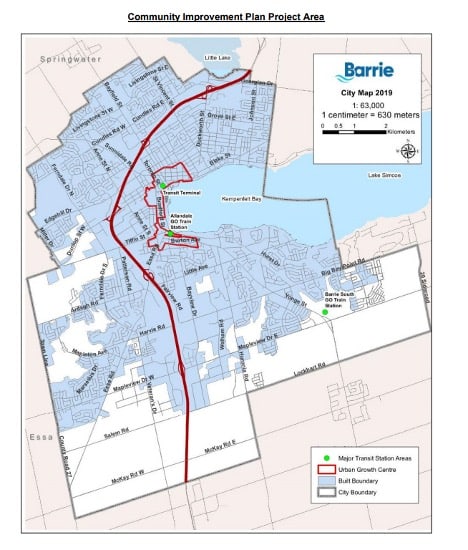The City of Barrie, one of the fastest growing cities in Ontario and one that is currently experiencing a huge boom in both residential and commercial real estate, is proposing changes to incentive programs offered through its Community Improvement Program (CIP) to facilitate incentives being given in a more timely manner.

At present, the city does not apply the charges and fees grant and tax increment grant until the Municipal Property Assessment Corporation (MPAC) has reassessed the property after the development (or redevelopment) has occurred. This can take up to two years; if the proposed amendments are accepted, the incentives will be applied when the developer applies for a building permit.
According to Andrew Gameiro, a planner with Barrie’s development services department, this would be a win for everyone involved.
“This approach would improve the administration of the program by eliminating the need to prepare cheque requisitions, particularly for development charge grants, which can be substantial,” said Gameiro.
“Issuing grant payments at the time of a building permit application also assists applicants in covering upfront costs associated with development, thereby making it easier for developers to move forward with construction.
“This is particularly important for large-scale projects in the Urban Growth Centre and the intensification corridors where development is generally encouraged.”
Barrie’s Urban Growth Centre (UGC), as defined by Ontario’s Places to Grow, comprises the downtown core and significant parts of historic Allandale, as well as waterfront and two transit hubs: the Allandale Waterfront GO station and the Barrie Transit terminal.
The UGC will continue to expand and serve as the focal point for the city’s high-density growth — both in terms of people and employment — and intensification in Barrie.
Barrie’s Growth Plans
Barrie has been one of the fastest growing cities in Ontario for decades; to ensure that services and facilities keep pace, the City has created a growth management strategy, which includes intensification in the existing built-up area as well as secondary development areas.
The City has also been developing policies and strategies to facilitate higher-density, mixed-use development in the UGC as well as within important intensification “nodes” — located at significant intersections — and “corridors”, which correspond to highly travelled routes into the downtown area.
Essa Road and Yonge Street, particularly the Yonge Street area which links the Barrie South GO station with the community, have been identified by the City of Barrie as focal points for higher-density development. Other intensification corridors include Bayfield Street, Duckworth Street and Dunlop Street West.
As indicated in The City of Barrie’s 2019 city map below , the built boundary — which consists of delineated built-up areas and undelineated built-up areas — does not extend to the city limits, as they do not take into account the nearly 2,300 hectares of land annexed from the Town of Innisfil in 2010. Intensification corridors link the city core to these and other areas outside the built boundary.

Barrie’s Community Improvement Program
The City of Barrie currently has three financial incentives through its CIP:
1. Affordable Housing Grant Program;
2. Redevelopment Grant Program; and
3. Heritage Preservation Grant Program.
Each has a different purpose and different eligibility criteria, and each provides different financial incentives, as indicated in the chart below.
|
Affordable Housing |
Redevelopment Grant |
Heritage Preservation |
Purpose |
To encourage purpose-built rental units, affordable housing units or at least 25% affordable units within a larger development |
To promote the redevelopment of underutilized sites in the UGC, strategic growth areas and brownfield sites |
To support the preservation of buildings on the Municipal Heritage Register |
Planning Act Application fee |
100% Planning Act application fees |
100% Planning Act application fees for the entire project |
NA |
Building Permit fees |
100% fees for affordable units |
50% for ground-related commercial, office or institutional components |
NA |
Development Charges |
100% DCs for affordable housing units |
50% DCs for ground-related commercial, office or institutional components |
NA |
|
25% DCs, to max of $250,000, for affordable units |
Tax increment grant for the ground-floor commercial, office or institutional elements, for five years |
NA |
Tax-increment grant |
Tax increment grant for affordable units over five years |
Tax-increment grant for developing a brownfield site, up to a $230,000 |
NA |
Other Grant |
Per-door grant of $10 per square foot for newly created affordable units, up to a max of $20,000 per unit and a property max of $200,000 |
|
50% renovation costs, up to $25,000 per property |
CIP section: |
Section 9.2 |
Section 7.2 |
Section 8.2 of the CIP |
To apply for the Affordable Housing incentive program, Gameiro specifies the following as the minimum requirements to include in your application:
- Cover letter outlining the application and how it meets CIP criteria
- Confirmation of the proposed housing costs and how they meet the definition of the CIP
- Floor plans for the proposed building(s), with all rooms labelled and floor areas confirmed
- Site plan identifying the building location, setbacks and parking
- Elevation plans of the building
- The number of affordable units, unit areas and number of bedrooms
Updates underway
After a statutory public meeting in February, city staff are examining input on the updates, which also propose reducing the application intake from three times a year to two, once in the spring and once in the fall. This proposal would reduce the time city staff spend reviewing applications.
In the event that application intake periods are reduced, it could become increasingly important to consider the city’s assessment matrix.
“The City’s CIP includes a scorecard which may be used by the Grant Review Committee to determine which applications meet the eligibility criteria of the CIP,” explained Gameiro.
“The scorecard evaluates redevelopment and affordable housing proposals using criteria that includes (but is not limited to): location, design features, density, mixed-use zoning opportunities, and number of affordable housing or purpose-built rental units.”

“The maximum score that may be awarded to an application is 150 points,” he continued.
“Applications with a score of 105 points or greater receive a positive recommendation from planning staff; applications scoring between 75 and 105 points receive a neutral recommendation and those with a score of less than 75 points are deemed ineligible for the CIP grant program.
“When submitting an application, applicants must demonstrate how their application advances the goals and objectives of the CIP.”
The first intake for applications runs to May 15, 2021, with city staff examining applications in June.
The Squarefoot Difference
At Squarefoot Commercial Group, we monitor public policy changes, and how they impact our clients and shape our community. Our team has over 55 years of commercial real estate experience, specializing in the Barrie real estate market as well as the greater Simcoe County area.
Squarefoot GIS maps provide clients with valuable insights into specific locations of interest; this comprises a visual of the area and surrounding community, as well as how the intended use would fit into the community and political, economic and social fabric of the area.
We visualize, analyze, and synthesize this data for our clients to assist them in making informed decisions about a site or a land assembly.
Contact us today to discuss your project or commercial real estate needs and how to take advantage of municipal incentives.


Reader Interactions